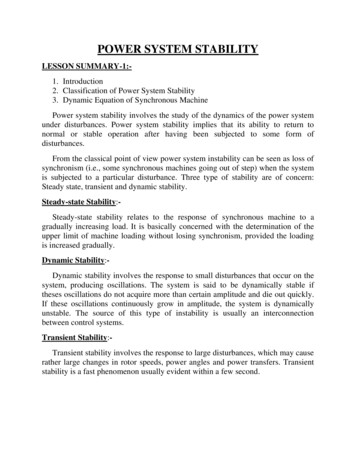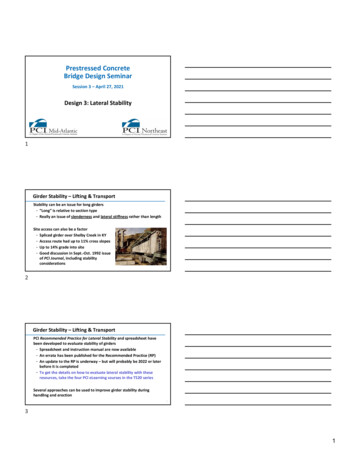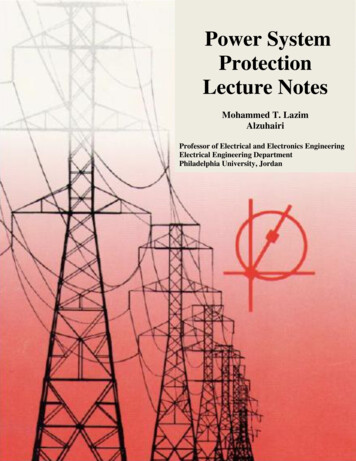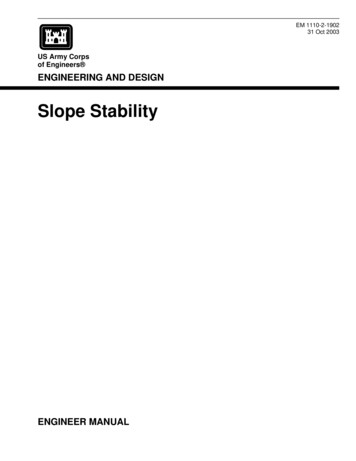
Transcription
POWER SYSTEM STABILITYLESSON SUMMARY-1:1. Introduction2. Classification of Power System Stability3. Dynamic Equation of Synchronous MachinePower system stability involves the study of the dynamics of the power systemunder disturbances. Power system stability implies that its ability to return tonormal or stable operation after having been subjected to some form ofdisturbances.From the classical point of view power system instability can be seen as loss ofsynchronism (i.e., some synchronous machines going out of step) when the systemis subjected to a particular disturbance. Three type of stability are of concern:Steady state, transient and dynamic stability.Steady-state Stability:Steady-state stability relates to the response of synchronous machine to agradually increasing load. It is basically concerned with the determination of theupper limit of machine loading without losing synchronism, provided the loadingis increased gradually.Dynamic Stability:Dynamic stability involves the response to small disturbances that occur on thesystem, producing oscillations. The system is said to be dynamically stable iftheses oscillations do not acquire more than certain amplitude and die out quickly.If these oscillations continuously grow in amplitude, the system is dynamicallyunstable. The source of this type of instability is usually an interconnectionbetween control systems.Transient Stability:Transient stability involves the response to large disturbances, which may causerather large changes in rotor speeds, power angles and power transfers. Transientstability is a fast phenomenon usually evident within a few second.
Power system stability mainly concerned with rotor stability analysis. For thisvarious assumptions needed such as: For stability analysis balanced three phase system and balanced disturbancesare considered. Deviations of machine frequencies from synchronous frequency are small. During short circuit in generator, dc offset and high frequency current arepresent. But for analysis of stability, theses are neglected. Network and impedance loads are at steady state. Hence voltages, currentsand powers can be computed from power flow equation.Dynamics of a Synchronous Machine :The kinetic energy of the rotor in synchronous machine is given as:KE 1/2Jws2 x10 -6 MJoule . . (1)WhereJ rotor moment of inertia in kg-m2ws synchronous speed in mechanical radian/sec.Speed in electrical radian iswse (P/2) ws rotor speed in electrical radian/sec . .(2)WhereP no. of machine polesFrom equation (1) and (2) we getKE orWhereKE M MJ . . (3)MJ moment of inertia inMJ.sec/elect. radian . (4)We shall define the inertia constant H, such thatGH KE WhereMJ . . . (5)G three-phase MVA rating (base) of machineH inertia constant in MJ/MVA or MW.sec/MVA
From equation (5), we can write,orM MJ.sec/elect. radian . (6)M MJ.sec/elect. degree . . (7)M is also called the inertia constant.Assuming G as base, the inertia constant in per unit isorM(pu) Sec2/elect.radian . (8)M(pu) Sec2/elect.degree . (9)LESSON SUMMARY-2:1.2.3.4.Swing equationMulti machine systemMachines swinging in unison or coherentlyExamplesSwing Equation:-PeTePmGENERATORTmWs(Fig.-1 Flow of power in a synchronous generator)Consider a synchronous generator developing an electromagnetic torque Te(anda corresponding electromagnetic power Pe) while operating at the synchronousspeed ws. If the input torque provided by the prime mover, at the generator shaft isTi, then under steady state conditions (i.e., without any disturbance).
Te Ti . (10)Here we have neglected any retarding torque due to rotational losses. Thereforewe haveTe ws Ti ws . (11)Te ws - Ti ws Pi - Pe 0 . (12)AndWhen a change in load or a fault occurs, then input power Pi is not equal to Pe.Therefore left side of equation is not zero and an accelerating torque comes intoplay. If Pa is the accelerating (or decelerating) power, then . (13)Pi- Pe WhereD damping coefficientθe electrical angular position of the rotorIt is more convenient to measure the angular position of the rotor with respectto a synchronously rotating frame of reference. Letδ θe -ws.t . (14) . (15)SoWhere δ is power angle of synchronous machine.Rotor FieldδWsReference rotatingaxisθeReference axis(Fig.2 Angular Position of rotor with respect to reference axis)Neglecting damping (i.e., D 0) and substituting equation (15) in equation (13)we get
MW . (16)Using equation (6) and (16), we getMW (17)Dividing throughout by G, the MVA rating of the machine,pu . (18) . (19)Wherepu . (20)orEquation (20) is called Swing Equation. It describes the rotor dynamics for asynchronous machine. Damping must be considered in dynamic stability study.Multi Machine System:In a multi machine system a common base must be selected. LetGmachine machine rating (base)Gsystem system baseEquation (20) can be written as: (21)Sopu on system base . (22) .(23)Where machine inertia constant in system baseMachines Swinging in Unison (Coherently) :Let us consider the swing equations of two machines on a common systembase, i.e., . . (24)
. . . (25)Since the machines rotor swing in unison,δ 1 δ 2 δ . .(26)Adding equations (24) and (25) and substituting equation (26), we get . (27)WherePi Pi1 Pi2Pe Pe1 Pe2Heq H1 H2Equivalent inertia Heq can be expressed as: . (28)Example1:A 60 Hz, 4 pole turbo-generator rated 100MVA, 13.8 KV has inertia constantof 10 MJ/MVA.(a) Find stored energy in the rotor at synchronous speed.(b) If the input to the generator is suddenly raised to 60 MW for an electricalload of 50 MW, find rotor acceleration.(c) If the rotor acceleration calculated in part (b) is maintained for 12 cycles,find the change in torque angle and rotor speed in rpm at the end of thisperiod.(d) Another generator 150 MVA, having inertia constant 4 MJ/MVA is put inparallel with above generator. Find the inertia constant for the equivalentgenerator on a base 50 MVA.Solution:(a) Stored energy GH 100MVA x 10MJ/MVA 1000MJ(b) Pa Pi-Pe 60-50 10MWWe know, M MJ.sec/elect.deg.\
Now 10 108 elect.deg./sec2So, α acceleration 108 elect.deg./sec2(c) 12 cycles 12/60 0.2sec. Change in δ ½ α.(Δt)2 ½.108.(0.2)2 2.16 elect.degNow α 108 elect.deg./sec2 60 x (108/360ᵒ) rpm/sec 18 rpm/secHence rotor speed at the end of 12 cycles () rpm 1803.6 rpm.(d) Heq 32MJ/MVALESSON SUMMARY-3:1. Power flow under steady state2. Steady-state Stability3. ExamplesPower Flow under Steady State:Consider a short transmission line with negligible resistance.VS per phase sending end voltageVR per phase receiving end voltageVs leads VR by an angle δx reactance of per transmission lineI jxVs-VR-(Fig.3-A short transmission line)
On the per phase basis power on sending end,SS PS j QS VSI* . . (29)From Fig.3 I is given asI or . . (30)I* From equation (29) and (30), we get . (31)SS NowVR VR VS VS so, VR VR* VR VS Equation (31) becomesSS PS jQS SoandδPS δδ . . (32) . . . (33)Qs Similarly, at the receiving end we haveSR PR j QR VRI* . (34)Proceeding as above we finally obtainQR PR . (35) . . (36)Therefore for lossless transmission line,PS P R . . (37)In a similar manner, the equation for steady-state power delivered by a losslesssynchronous machine is given by
Pe P d δ (38) Where Eg is the rms internal voltage, Vt is the rms terminal voltage, xd is thedirect axis reactance (or the synchronous reactance in a round rotor machine) and δis the electrical power angle.Steady-state Stability:The steady state stability limit of a particular circuit of a power system definedas the maximum power that can be transmitted to the receiving end without loss ofsynchronism.Now consider equation (18), (39)WhereAndPe δ . (40)Let the system be operating with steady power transfer ofwith torqueangle . Assume a small increment ΔP in the electric power with the input fromthe prime mover remaining fixed atcausing the torque angle to change to(. Linearizing the operating point (we can write . (41)The excursions ofare then described by . . (42) . (43)oror[Mp2 Wherep . . (44)
The system stability to small changes is determined from the characteristicequationMp2 Where two roots areAs long asp 0 . (45) . (46)is positive, the roots are purely imaginary and conjugateand system behavior is oscillatory about . Line resistance and damper windingsof machine cause the system oscillations to decay. The system is therefore stablefor a small increment in power so long asWhenδδis negative, the roots are real, one positive and the othernegative but of equal magnitude. The torque angle therefore increases withoutbound upon occurrence of a small power increment and the synchronism is soonlost. The system is therefore unstable forδis known as synchronizing coefficient. This is also called stiffness ofsynchronous machine. It is denoted as Sp. This coefficient is given byδ (47)If we include damping term in swing equation then equation (43) becomesδδorororδδ . (48)
Where (49)and . . (50)So damped frequency of oscillation,AndTime Constant, T . (51) Example2:Find the maximum steady-state power capability of a system consisting of agenerator equivalent reactance of 0.4pu connected to an infinite bus through aseries reactance of 1.0 p.u. The terminal voltage of the generator is held at1.10 p.u.and the voltage of the infinite bus is 1.0 p.u.Solution:Equivalent circuit of the system is shown in Fig.4.(Fig.4 Equivalent circuit of example2) . (i)δ . (ii)I Using equation (i) and (ii)δδθθδθθθθ . (iii)
Maximum steady-state power apab l tyreal part of equation is zero. Thusrea hedhe δ9 ᵒ, i.e.,θ99p9pLESSON SUMMARY-4:1. Transient Stability-Equal area criterion2. Applications of sudden change in power input3. ExamplesTransient Stability-Equal Area Criterion:The transient stability studies involve the determination of whether or notsynchronism is maintained after the machine has been subjected to severedisturbance. This may be sudden application of load, loss of generation, loss oflarge load, or a fault on the system.A method known as the equal area criterion can be used for a quick predictionof stability. This method is based on the graphical interpretation of the energystored in the rotating mass as an aid to determine if the machine maintains itsstability after a disturbance. This method is only applicable to a one-machinesystem connected to an infinite bus or a two-machine system. Because it providesphysical insight to the dynamic behavior of the machine.Now consider the swing equation (18),oror . (52)
As shown in Fig.5, in an unstable system, δ increases indefinitely with time andmachine looses synchronism. In a stable system, δ undergoes oscillations, whicheventually die out due to damping. From Fig.4, it is clear that, for a system to bestable, it must be that 0 at some instant. This criterion ( 0) can simply beobtained from equation (52).(Fig. 5 A plot of δ (t))Multiplying equation (52) by, we have . (53)This upon integration with respect to time givesdδ . . (54)Where accelerating power and δ is the initial power anglebefore the rotor begins to swing because of a disturbance. The stability ( 0)criterion implies thatdδ . (55)For stability, the area under the graph of accelerating power versus δ must bezero for some value of δ; i.e., the positive (accelerating) area under the graph mustbe equal to the negative (decelerating) area. This criterion is therefore know as theequal area criterion for stability and is shown in Fig. 6.
(Fig.6 Power angle characteristic)Application to sudden change in power input:In Fig. 6 point ‘a’ corresponding to the δ is the initial steady-state operatingpoint. At this point, the input power to the machine,, whereis thedeveloped power. When a sudden increase in shaft input power occurs to , theaccelerating power , becomes positive and the rotor moves toward point ‘b’We have assumed that the machine is connected to a large power system so that Vt does not change and also xd does not change and that a constant field currentmaintains Eg . Consequently, the rotor accelerates and power angle begins toincrease. At pointand δ δ1. Butis still positive and δ overshoots ‘b’,the final steady-state operating point. Now is negative and δ ultimately reaches amaximum value δ2 or point ‘c’ and swing back towards point ‘b’. Therefore therotor settles back to point ‘b’, which is ultimate steady-state operating point.In accordance with equation (55) for stability, equal area criterion requiresArea A1 Area A2orδ dδδdδ . (56)or . (57)ButWhich when substituted in equation (57), we get . . (58)
On simplification equation (58) becomes . . (59)Example 3:A synchronous generator, capable of developing 500MW power per phase,operates at a power angle of 8ᵒ. By how much can the input shaft power beincreased suddenly without loss of stability? Assume that Pmax will remainconstant.Solution:Initially, 8ᵒδ 69.6MW(Fig. 7 Power angle characteristics)Let δm be the power angle to which the rotor can swing before losingsynchronism. If this angle is exceeded, Pi will again become greater than Pe and therotor will once again be accelerated and synchronism will be lost as shown in Fig.7. Therefore, the equal area criterion requires that equation (57) be satisfied withδm replacing δ2.From Fig. 7 δm π-δ1. Therefore equation (59) becomes (i)Substituting 0.139radian in equation (i) gives99 (ii)Solving equation (ii) we get, δ1 50ᵒNowδInitial power developed by machine was 69.6MW. Hence without loss ofstability, the system can accommodate a sudden increase of
9MW per phase 3x313.42 940.3 MW (3-φ) of input shaft power.LESSON SUMMARY-5:1. Critical clearing angle and critical clearing time2. Application of equal area criteriona) Sudden loss of one parallel lineCritical Clearing Angle and Critical Clearing Time:If a fault occurs in a system, δ begins to increase under the influence ofpositive accelerating power, and the system will become unstable if δ becomesvery large. There is a critical angle within which the fault must be cleared ifthe system is to remain stable and the equal area criterion is to be satisfied.This angle is known as the critical clearing angle.(Fig. 8 Single machine infinite bus system)Consider a system as shown in Fig. 8 operating with mechanical inputatsteady angle.as shown by point ‘a’ on the power angle diagram asshown in Fig. 9. Now if three phase short circuit occur at point F of the outgoingradial line , the terminal voltage goes to zero and hence electrical power output ofthe generator instantly reduces to zero i.e.,and the state point drops to ‘b’.The acceleration area A1 starts to increase while the state point moves along bc. At time tc corresponding clearing angle δc, the fault is cleared by the opening ofthe line circuit breaker. tc is called clearing time and δc is called clearing angle.After the fault i s cleared, the system again becomes healthy and transmitspower Pe Pmax sinδ, i.e., the state point shifts to‘d’ on the power anglecurve. The rotor now decelerates and the decelerating area A2 begins to increasewhile the state point moves along d-e. For stability, the clearing a ngle, δc, mustbe such that area A1 area A2.
δ characteristics)(Fig. 9Expressing area A1 Area A2 mathematically we have,δδδδdδδδ dδδδδδδδδδδδ . . (60) . (61)δAlsoUsing equation (60) and (61) we get,δδδδδδδδ (62)Where δ clearing angle, δ initial power angle, and δ power angle towhich the rotor advances (or overshoots) beyond δFor a three phase fault with Pe 0, . (63)Integrating equation (63) twice and utilizing the fact thatδtand t 0 yieldsδ . (64)
If t is the clearing time corresponding to a clearing angle δ , then we obtainfrom equation (64),δtSotδ (65)Note that δ can be obtained from equation (62). As the clearing of faulty line isdelayed, A1 increases and so does δ to find A2 A1 till δδ as shown in Fig.10.(Fig. 10 Critical clearing angle)For a clearing angle (clearing time) larger than this value, the system would beunstable. The maximum allowable value of the clearing angle and clearing time forthe system to remain stable are known as critical clearing angle and criticalclearing time respectively.From Fig. 10,. Substituting this in equation (62) we have,δδδδδδδδδδδδδδδδδ . . . (66)Using equation (65) critical clearing angle can be obtained ast . . . (67)
Application of the Equal Area Criterion:(1) Sudden Loss of One of parallel Lines:PiInfiniteBus V 0ᵒ(a)Eg δPiX1Xd V 0ᵒX2Switched Off(b)(Fig. 11 Single machine tied to infinite bus through two parallel lines)Consider a single machine tied to infinite bus through parallel lines as shown inFig. 11(a). The circuit model of the system is given in Fig. 11(b).Let us study the transient stability of the system when one of the lines issuddenly switched off with the system operating at a steady load. Before switchingoff, power angle curve is given byδδImmediately on switching of line 2, power angle curve is given byδIn Fig. 12, whereinasoperating initially with a steady state power transferon curve I.δ. The system isat a torque angle δ
δ0δ1δ2πδ(Fig. 12 Equal area criterion applied to the opening of one of the two lines inparallel)On switching off line2, the electrical operating point shifts to curve II (point b).Accelerating energy corresponding to area A1is put into rotor followed bydecelerating energy for δ δ1. Assuming that an area A2 corresponding todecelerating energy (energy out of rotor) can be found such that A1 A2, thesystem will be stable and will finally operate at c corresponding to a new rotorangle is needed to transfer the same steady power.If the steady load is increased (line Pi is shifted upwards) a limit is finallyreached beyond which decelerating area equal to A1 cannot be found and therefore,the system behaves as an unstable one. For the limiting case, δ1 has a maximumvalue given byδδδLESSON SUMMARY-6:1. Sudden short circuit on one of parallel linesa) Short circuit at one end of lineb) Short circuit at the middle of a line2. ExampleSudden Short Circuit on One of Parallel Lines:(1) Short circuit at one end of line:Let us a temporary three phase bolted fault occurs at the sending end of one ofthe line.
X1 Eg δXdInfiniteBus V 0ͦᵒPiX2(a)X1 Eg δXdInfiniteBus V 0ͦᵒPiX2(b)(Fig.13 Short circuit at one of the line)Before the occurrence of a fault, the power angle curve is given byδδThis is plotted in Fig. 12.Upon occurrence of a three-phase fault at the generator end of line 2 , generatorgets isolated from the power system for purpose of power flow as shown Fig. 13(b). Thus during the period the fault lasts.The rotor therefore accelerates and angles δ increases. Synchronism will belost unless the fault is cleared in time. The circuit breakers at the two ends of thefaulted line open at time tc (corresponding to angle δc), the clearing time,disconnecting the faulted line. The power flow is now restored via the healthy line(through higher line reactance X2 in place of (), with power angle curveδδ
(Fig. 14 Equal area criterion applied to the system)Obviously,. The rotor now starts decelerate as shown in Fig 14.The system will be stable if a decelerating area A2 can be found equal toaccelerating area A1before δ reaches the maximum allowable value δ . As areaA1 depends upon clearing time tc (corresponding to clearing angle ), clearingtime must be less than a certain value (critical clearing time) for the system to bestable.(2) Short circuit at the middle of a line:When fault occur at the middle of a line or away from line ends, there is somepower flow during the fault through considerably reduced. Circuit model of thesystem during the fault is shown in fig. 15 (a). This circuit reduces to fig. 15 (c)through one delta-star and star-delta conversion.The power angle curve during fault is given byδX’dδX1XaGXbX2/2Xc(a)X2/2V
X’1XaXbXcGV(b)XIIVG(c)(Fig.15 Circuit Model)andas in Fig. 12 andas obtained above are all plotted in Fig. 16.(Fig. 16 Fault on middle of one line of the system with δc δcr)Accelerating area A1 corresponding to a given clearing angle δ is less in thiscase. Stable system operation is shown in Fig. 16, wherein it is possible to find anarea A2 equal to A1 forδδ . As the clearing angle δ is increased, area A1increases and to find A2 A1, δ increases till it has a valueδ , the maximumallowable for stability. This case of critical clearing angle is shown in Fig. 17.
(Fig. 17 Fault on middle on one line of the system)Applying equal area criterion to the case of critical clearing angle of Fig. 17, wecan writeδ dδδdδWhere . . . (68)δIntegrating we getδorδδδδδδδδδδδδδδδδThis critical clearing angle is in radian. The equation modifies as below if theangles are in degreeδδδδδExample 4:Find the critical clearing angle for the system shown in Fig. 18 for a three phasefault at point P. The generator is delivering 1.0 pu. Power under prefaultconditions.
E 14 V 1.0 0ᵒj0.15j0.15(Fig. 18)Solution:1. Prefault Operation:- Transfer reactance between generator and infinite busisXI 0.25 0.17 0.71δ9δThe operating power angle is given by9δor δrad2. During Fault:- The positive sequence reactance diagram during fault ispresented in Fig. 17.j0.15j0.28j0.15j0.25j0.17j0.15 E 1.2puj0.14j0.14j0.15 V 1.0 0ᵒ(a)Positive sequence reactance diagram during faultj0.25j0.145j0.145j0.17 E 1.2puj0.0725(b) Network after delta-star conversion V 1.0 0ᵒ
XII E 1.2pu V 1.0 0ᵒ(c) Network after star- delta conversion(Fig.19)Converting delta to star, the reactance network is changed to that Fig. 19 (b).Further upon converting star to delta, we obtain the reactance network of Fig.19(c). The transfer reactance is given by 2.424δ9δ3. Post fault operation(faulty line switched off):δδWith reference to Fig. 16 and equation (68), we haveδradTo find critical clearing angle, areas A1 and A2 are to be equated.δ9δ dδAndNoworδA1 A2δ9δ dδ 9orororδ dδ9δδδ99δδ dδδ
orδLESSON SUMMARY-7:-91. Step by step solution of swing equation2. Multimachine stability studies3. Factors affecting transient stabilityStep by Step Solution of Swing Equation:The swing equation isδ (69)Its solution gives a plot of δ versus t. The swing equation indicates that δ startsdecreasing after reaching maximum value, the system can be assumed to be stable.The swing equation is a non-linear equation and a formal solution is not feasible.The step by step solution is very simple and common method of solving thisequation. In this method the change in δ during a small time interval Δt iscalculated by assuming that the accelerating powercalculated at the beginningof the interval is constant from the middle of the preceding interval to the middleof the interval being considered.Let us consider the nth time interval which begins at t (n-1) Δt. The angularposition of the rotor at this instant is δn-1(Fig. 20 c). The accelerating powerand hence, acceleration αn-1 as calculated at this instant is assumed to be constantfrom t (n-3/2) Δt to (n-1/2) Δt.During this interval the change in rotor speed can be written as (70)Thus, the speed at the end of nth interval is . . (71)Assume the change in speed occur at the middle of one interval, i.e., t (n-1)Δtwhich is same the same instant for which the acceleration was calculated. Then thespeed is assumed to remain constant till the middle of the next interval as shown inFig. 18(b). In other words, the speed assumed to be constant at the valuethroughout the nth interval from t (n-1) Δt to t n Δt.
(a)(b)(c)(Fig. 20 Step by step solution of swing equation)The change in angular position of rotor during nth time interval is . . (72)And the value of δ at the end of nth interval is
. . (73)This is shown in Fig. 20 (c). Substituting equation (70) into equation (71) andthe result in equation (72) leads to . (74)By analogy with equation (72) . (75)Substituting the value offrom equation (75) into equation (74) . (76)Equation (76) gives the increment in angle during any interval (say nth) interms of the increment during (n-1) th interval.During the calculations, a special attention has to be paid to the effects ofdiscontinuities in the accelerating powerwhich occur when a fault is applied orcleared or when a switching operation takes place. If a discontinuity occurs at thebeginning of an interval then the average of the values ofbefore and after thediscontinuity must be used. Thus, for calculating the increment in occuring in thefirst interval after a fault is applied at t 0, equation (76) becomes . (77)Where, is the accelerating power immediately after occurrence of the fault.Immediately before the occurrence of fault, the system is in steady state withand the previous increment in rotor angle is zero.Multimachine stability Studies:The equal-area criterion cannot be used directly in systems where three or moremachines are represented, because the complexity of the numerical computationsincreases with the number of machines considered in a transient stability studies.To ease the system complexity of system modeling, and thereby computationalburden, the following assumptions are commonly made in transient stabilitystudies:1. The mechanical power input to each machine remains constant.2. Damping power is negligible.3. Each machine may be represented by a constant transient reactance in serieswith a constant transient internal voltage.
4. The mechanical rotor angle of each machine coincides with δ.5. All loads may be considered as shunt impedances to ground with valuesdetermined by conditions prevailing immediately prior to the transientconditions.The system stability model based on these assumptions is called the classicalstability model, and studies which use this model are called classicalstability studies.Consequently, in the multi-machine case two preliminary steps are required.1. The steady-state prefault conditions for the system are calculated using aproduction-type power flow program.2. The prefault network representation is determined and then modified toaccount for the fault and for the postfault conditions.The transient internal voltage of each generator is then calculated using theequation . (80)Where Vt is the corresponding terminal voltage and I is the output current. Eachload is converted into a constant admittance to ground at its bus using the equation (81)Wherethe load and VL is is the magnitude of the corresponding busvoltage. The bus admittance matrix which is used for the prefault power-flowcalculation is now augmented to include the transient reactance of each generatorand the shunt admittance of each load, as shown in Fig. 21. Note that the injectedcurrent is zero at all buses except the internal buses of the generators.(Fig. 21 Augmented network of a power system)In the second preliminary step the bus admittance matrix is modified tocorrespond to the faulted and post fault conditions. During and after the fault thepower flow into the network from each generator is calculated by the
corresponding power angle equation. For example, in Fig. 21 the power output ofgenerator 1 is given by . . (82)Whereequals. Similar equations are written forandusingtheelements of the 3X3 bus admittance matrices appropriate to the fault orpostfault condition. Theexpressions form part of the equationsi 1, 2, 3 (83)Which represent the motion of each rotor during the fault and post faultperiods. The solutions depend on the location and duration of the fault, and Ybusresulting when the faulted line is removed.Factors Affecting Transient Stability:Various methods which improve power system transient stability are1. Improved steady-state stabilitya) Higher system voltage levelsb) Additional transmission linec) Smaller transmission line series reactanced) Smaller transfer leakage reactancee) Series capacitive transmission line compensationf) Static var compensators and flexible ac transmission systems(FACTs)2. High speed fault clearing3. High speed reclosuer of circuit breaker4. Single pole switching5. Large machine inertia, lower transient reactance6. Fast responding, high gain exciter7. Fast valving8. Breaking resistor
Power system stability involves the study of the dynamics of the power system under disturbances. Power system stability implies that its ability to return to . Now 10 108 elect.deg./sec2 So, α acceleration 108 elect.deg./sec2 (c) 12 cycles 12/60 0.2sec. Change in δ ½ α.(Δt)2 ½.108.(0.2)2 2.16 elect.deg










